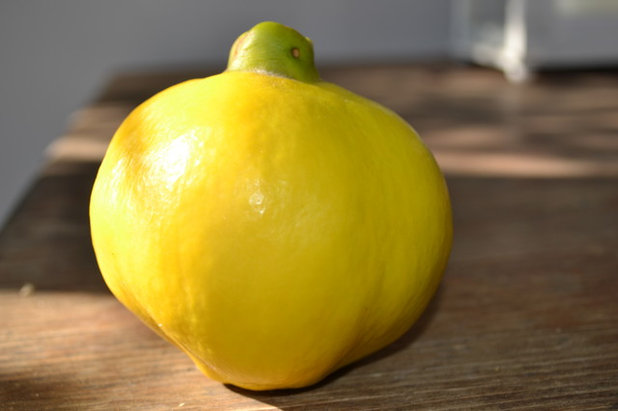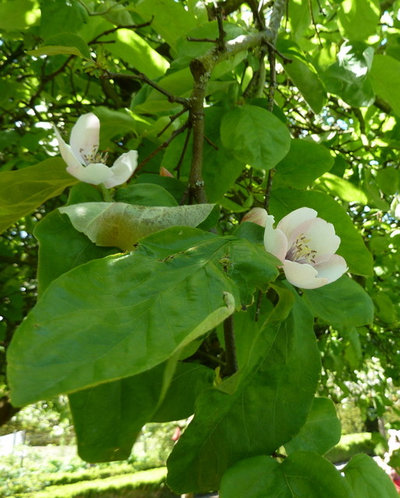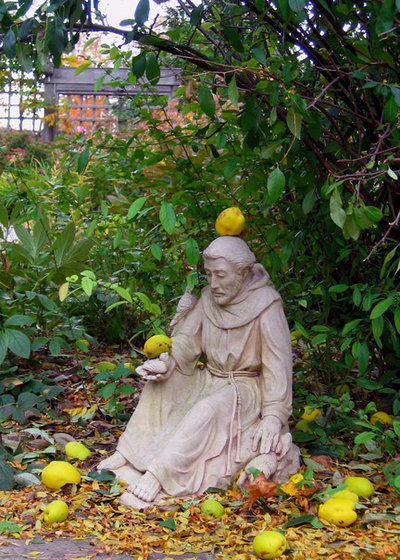Everyone knows apples and pears. But the quince — now that’s something different. It’s a member of the same family grouping, known as pome fruits, with many of the same characteristics, including beautiful pale pink or white spring flowers; rich, dark green summer leaves with a white undertone; autumn color; and interesting twisted branches that enliven a winter garden. Quinces are also fairly hardy and want winter chill, though they’re not fond of humidity. The large fall fruits resemble apples or pears, depending on the variety, and are usually bright yellow, much like a lemon, though you can find some with a green or orange cast. Many experts consider the quince to be the golden apple of legends and myths.
That being said, there are some notable differences that can be seen in these family members. Unlike pears and to a lesser extent apples, quinces are slow growing, though they’re long lived once they reach maturity. The trees are also relatively small, usually between 10 and 25 feet in height, and can be grown as a shrub or a tree. Smaller varieties can be grown in a large barrel or container. Quinces are also self-fertile.
A few quince varieties might be sweet enough to eat off a tree, but usually they’re too tart to eat raw. They are great for jams, jellies, preserves and syrups; mellower when cooked; make a nice addition to the apples in an apple pie; and can be used as the base for candies.
Paying attention to botanical names is important if you’re looking for a true fruiting quince. Its “real” name is
Cydonia oblonga. You might more readily find a flowering quince, a member of the
Chaenomeles genus. While the different flowering quinces do have beautiful spring flowers and set a type of fruit, they’re not quite as showy of a landscape plant, and the fruit is marginal.

Girasole Sonoma
Where to grow: In USDA zones 4 through 9 it will grow reliably, though it can be grown in zone 3 as well.
Favorites: Apple (Orange), Aromatnaya*, Champion*, Cooke’s Jumbo, Havran, Limon, Karp’s Sweet*, Kuganskaya*, Pineapple, Portugal, Seeker Gevrek, Smyrna, Van Deman
*Can be eaten fresh off the tree.

Wendy Cutler
Planting guidelines: Look for a bare-root or container tree with evenly spaced branches. Plant when the soil can be worked; for bare-root trees, in late winter or spring; for container plants, between fall and early summer as long as the soil can be worked.
Choose a spot in full sun with good drainage; quinces aren’t fussy about soil type. Dig a hole as deep as and twice as wide as the rootball and set the plant in place, spreading out the roots. Fill in with soil and water thoroughly. Add mulch up to about 3 inches from the trunk to suppress weeds and prevent water loss.
Remove any weak or crossing branches. If you want to train your quince as a tree, remove all central stems except for one to serve as a trunk, then prune the branches into an open vase shape. If you want to espalier your quince, remove all but a few strong branches on each side.

Enroot Landscape Planning and Design
Care requirements: Water deeply every two to three weeks if you don’t have spring or summer rain. Lightly apply a low-nitrogen fertilizer around the root zone in late winter and early summer. Thin only if the fruit load threatens to break the branches.
Pruning: Unlike most fruit trees, a quince tree doesn’t need much pruning. If you’re growing it as a shrub, keep up to five central stems as trunks and thin out tightly angled branches to open up the interior of the plant. If you’re growing it as a tree, remove any additional strong central trunks and any crossing or tightly angled branches, as well as those growing below the preferred canopy line.
Cut the branches back by about 50 percent the first few years. After that simply prune to shape and remove dead or weak branches. Remove any suckers growing from the base of the plant.
Pests and diseases: Pests are not much of a problem, although codling moths can sometimes invade. Fireblight is usually the real issue with these trees, leaving the plant with dead branches and leaves that look like they’ve literally been through a fire. It’s an easily spread disease, so encourage air circulation with an open shape and immediately prune off infected branches about 6 inches below where the disease appears. Sterilize your pruning tools after each cut (yes, it’s that easily spread) and dispose of clippings well away from the rest of the garden.
Harvest: Once the fruit is fully colored in fall, it’s time to harvest. Yellow and orange fruits should have no green left; green varieties will have mellowed in color. You can also tell if it’s ready by the strong fragrance of the fruit and the fact that it will easily twist away from the stem. The fruit does bruise easily, even though it looks fairly sturdy, so handle with care.
Store for a couple of months in the refrigerator while you look for new quince recipes but beware: Its fragrance may be delightful but overwhelming.





